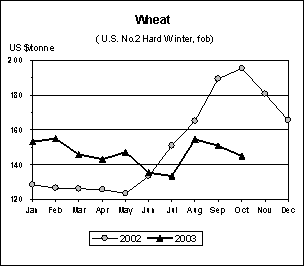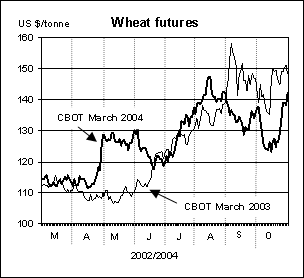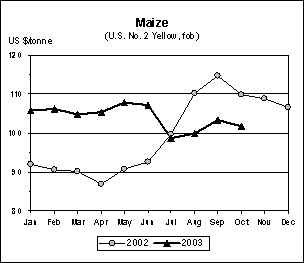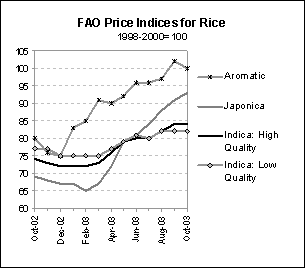Cereals: Export prices
|
|
|
|
Prices for most cereals remain under downward pressure
|
 |
| | 2003 | 2002 | | | October | August | October | | | ( US$/tonne ) | |
United States | | | | | Wheat | 150 | 155 | 196 | | Maize | 104 | 100 | 110 | | Sorghum | 111 | 106 | 121 | |
Argentina | | | | | Wheat | 148 | 155 | 155 | | Maize | 101 | 98 | 105 | |
Thailand | | | | | Rice white | 199 | 198 | 193 | | Rice, broken | 159 | 151 | 161 |
* Prices refer to the monthly average. For sources see Appendix Tables A.6 and A.7.
International wheat prices during the past two months weakened with values from most origins mostly below last year’s levels. The main factor for the decline has been the apparent sharp reduction in global import demand. Although tighter supplies in Europe and the weakening of the value of the US dollar compared to other major world currencies provided some support to the US wheat prices, US wheat No. 2 (HRW, fob) averaged US$150 per tonne in October, some US$5 per tonne lower than in August and as much as US$46 per tonne, or 23 percent, below the price in October 2002. In Argentina, despite the official downgrading of the forecast for new crop after a two-month drought, prices were also generally weaker than last year’s levels. The lack of upward pressure on Argentine prices also stems from a slower pace in exports, competition with Australia and Canada and interruption of sales to the Islamic Republic of Iran, the largest Argentine wheat customer after Brazil. In October, the Argentine Trigo Pan prices averaged US$148 per tonne (fob), some US$7 per tonne, below the corresponding period last year.

 Correspondingly, fundamentals in the futures market were also characterized by weak demand and strong competition among the major exporters (all except the EU). At the Chicago Board of Trade (CBOT), the US wheat futures lost more ground through mid-October mainly because of concerns over US export prospects and larger sales by other exporters to some of the more traditional US markets. However, wheat prices started to recover in recent weeks, supported by further declines in the US dollar and more US wheat purchases by China and the EU. By late October, March wheat futures contracts were quoted at US$142 per tonne, representing an increase of about US$5 per tonne since August, though still US$8 per tonne below the corresponding period last year. The prospects for price movements in the coming months remain aligned with FAO’s earlier expectations. Although tight supply conditions in Europe are likely to persist throughout the season, sufficient export availabilities elsewhere, combined with reduced demand by some of the world’s leading importing countries and good winter wheat conditions, could add to more downward pressure on prices in the months ahead.
Export prices for nearly all types of coarse grains increased slightly over the past two months; stronger demand for US sorghum and European feed barley resulted in some upward movements in their values; and maize prices also rose slightly with the US maize export prices averaging US$104 per tonne in October, still US$6 per tonnes below the corresponding period last year. This year’s strong rebound in maize production in the United States, abundant supplies in Brazil and soaring freight rates are among the remain reasons for weaker maize prices. Maize futures were under downward pressure during September and early October as the direct result of seasonal harvest pressure in the US. However, since the mid-October, the CBOT March 2004 maize futures were positively influenced by strong rallies in soybeans and rumours of China reducing it exports due to a tighter domestic situation. Nevertheless, as for wheat, the current supply and demand prospects for the global maize market do not augur any major upturn in prices in the coming months.

 International rice prices have continued to rally since August, and the FAO Export Price Index (1998–00=100) rose from 85 in August to 87 in September and 88 in October. This strengthening affected all rice categories except for the lower-quality Indica rice, the index of which has remained at 82 since August. The upward price pressure softened somewhat in October when crops started to reach the markets in several important exporting countries.
 Within the high-quality Indica rice categories, the price of US long grain N.2, 4% has surged by US$44 to US$349 per tonne since August, reflecting a tightening of supplies in the United States. By contrast, a release of high-quality supplies from stocks by the government in Thailand dampened the upward pressure on prices and the increase was rather moderate for the Thai 100%B, which moved up a mere US$1 per tonne over the three-month period. These price movements have led to a restoration of the price premium that US quality rice usually holds and that had almost disappeared in May.
By contrast, the prices of the lower-quality rice have remained stable since August, as illustrated by the level of the FAO sub-index for that category which remained constant at 82. This stability, however, reflected diverging tendencies, as prices of Pakistan rice fell sharply in October with the arrival of the new crop, while prices in Thailand and Viet Nam strengthened.
The FAO Japonica Price Index moved in an upward trend from 84 in August to 94 in October. The strength reflects the opening of several import tenders by Japan and the Republic of Korea. In addition, the crop shortfalls in those two countries this year might have intensified the perception of an impending tightening of supplies for Japonica rice.
The Aromatic Rice Price Index also strengthened by two points between August and October, reflecting an increase of US$10 per tonne both for the India Basmati and US$15 for the Thai fragrant rice.
The price outlook for the next few months continues to be positive as current prospects confirm a tightening of market conditions. Moreover, the intention of the major exporters appears to be to avoid a repetition of the market situation in 2001 and 2002, when strong competition among suppliers led to tumbling world prices. In this connection, the Council for Rice Trade Cooperation, whose members are China, India, Pakistan, Thailand and Viet Nam, is to meet in November to discuss and exchange information on rice market prospects and possibly decide on a common export reference price.
|





